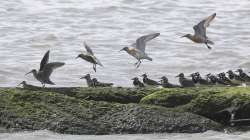Largest bird die-off ever linked to marine heat wave: Study
The unprecedented death of nearly one million birds between 2015 and 2016, whose remains washed ashore in Alaska, US, was brought on by a severe and long-lasting marine heat wave, a new study says.

The unprecedented death of nearly one million birds between 2015 and 2016, whose remains washed ashore in Alaska, US, was brought on by a severe and long-lasting marine heat wave, a new study says. The study, published in the journal PLOS ONE, said the common murre underwent the largest avian die-off ever witnessed due to an extreme marine heat wave known as "the blob" which squeezed out the bird's fish food supply in the Pacific Ocean. "We believe that the smoking gun for common murres -- beyond the marine heat wave itself -- was an ecosystem squeeze: fewer forage fish and smaller prey in general, at the same time that competition from big fish predators like walleye, pollock and Pacific cod greatly increased," said study co-author Julia Parrish from the University of Washington in the US.
According to the study, warmer surface water temperatures off the Pacific coast -- a phenomenon known as "the blob" -- first occurred in the fall and winter of 2013, and persisted through 2014 and 2015.
This warming then increased through 2015-2016 due to a weather phenomenon called El Nino affecting wind and cloud movement patterns.
According to the scientists, this period saw a number of other species experience mass die-offs, including tufted puffins, Cassin's auklets, sea lions and baleen whales.
But the common murre die-off was by far the largest, they said.
Between May 2015 and April 2016, the researchers said, about 62,000 murre carcasses washed off onto beaches from central California through Alaska in the US -- a number that is 1,000 times more than normal for these shores.
"The magnitude and scale of this failure has no precedent. It was astonishing and alarming, and a red-flag warning about the tremendous impact sustained ocean warming can have on the marine ecosystem," said lead author John Piatt, a research biologist at the US Geological Survey.
Based on their analysis of fisheries studies conducted during this time period, the researchers said persistent warm ocean temperatures associated with "the blob" increased the metabolism of several marine organisms across the food chain.
These included small cold-blooded organisms from zooplankton, and foraging fishes, up through larger predatory fish like salmon and pollock.
As the predatory fished ate more than usual, the demand for food at the top of the food chain was unsustainable, the scientists said.
The once-plentiful schools of forage fish that murres relied on became harder to find as a result, they added.
"Food demands of large commercial groundfish like cod, pollock, halibut and hake were predicted to increase dramatically with the level of warming observed with the blob, and since they eat many of the same prey as murres, this competition likely compounded the food supply problem for murres, leading to mass mortality events from starvation," Piatt said.
The scientists believe the common murre deaths may help explain other die-offs which occurred during this marine heat wave period.
The study noted that scientists have also recently identified another marine heatwave forming off the Washington coast and up into the Gulf of Alaska in the US.
"All of this -- as with the Cassin's auklet mass mortality and the tufted puffin mass mortality -- demonstrates that a warmer ocean world is a very different environment and a very different coastal ecosystem for many marine species," Parrish said.
Also Read: Low-fat milk linked to slower ageing in adults: Study
Also Read: Mysterious gas-like objects spotted in the centre of Milky Way